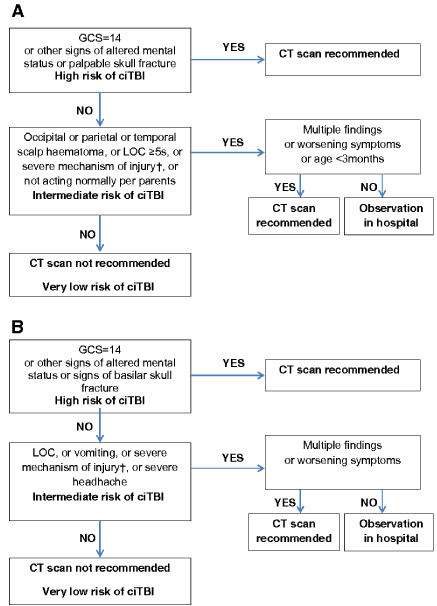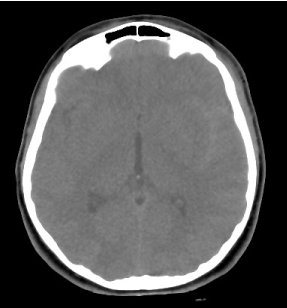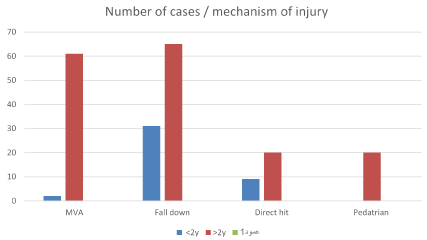Minor head trauma, Pediatric, ciTBI, radiation
Head injuries in children are one of the most common cause of the emergency department visits. The majority of these cases falls under the category of minor head trauma with peak ages of presentation at 0-4 and 15-19 years.
Despite that the most of these cases did not require any investigations, CT- head has been widely used to exclude serious brain injuries. There is established fact that unnecessary use of medical imaging increases the risk of radiation related complication, like cancer. This is particularly a concern for paediatric age group.
There are various validated tools to review the need of CT head in minor head trauma. Pediatric Emergency Care Applied Research Network (PECARN) rule is one of the establish tool and has been widely reported to be successful in minimising unnecessary CT scans in minor head trauma without missing serious cases who need investigation and further management [1,2]. In our centre King Abdullah specialized children hospital (KASCH), Riyadh, Saudi Arabia with collaboration between Radiology, paediatric and paediatric emergency medicine department, we retrospectively reviewed our current practice of use of CT scan in minor head trauma and the role of PECARN rule in decreasing unnecessary imaging.
This Retrospective review was conducted on all patients under the age 14, presented to the emergency department of KASCH between April 2015 to April 2017. The clinical data was collected from the patient’s chart reviewing the mechanism of injury while two-paediatric radiologist has reviewed the CT-head blindly. In keeping with the PECARN study for very low risk group for ciTBI, we excluded patients with an initial GCS less or equal 14, patients with history of vomiting, loss of conscious, palpable skull fracture, scalp hematoma, altered mental status and patient with known previous brain insult or tumour. In addition, we also excluded patients who had a CT scan performed prior to the ED consultation and patient with history of trauma more than 24h. The study group was divided according to the patient age (< 2y or > 2y) to meet PECARN rule (Figure 3), and we also studied mechanism of head trauma. CT scans were performed with helical CT scanners, with radiographic slices separated by 5 mm or less. CT scans were reviewed by 2 radiologists blindly.

Figure 3. PECARN rules for children: (A) younger than 2 years, (B) aged 2 years and older (3).
A 588 children presented to the ED with head trauma where 208 (35.4%) could be classified as minor head trauma as per PECARN rule. All of these children had CT head performed.
Only 17 patients out of 208 (8.2%) had some positive findings on CT-head which were mainly insignificant. Only 3 patients (1.4 %) needed admission for observation, while none of the patient required surgical intervention.
The significant brain injury findings: multiple left temporal bone fracture with left temporal contusion and subarachnoid hemorrhage Figure (1), right temporal subarachnoid haemorrhage, left parito-temporal subarachnoid haemorrhage.

Figure 1. Left temporal contusion and subarachnoid haemorrhage.
2021 Copyright OAT. All rights reserv
The bar chart showing fall down as the most common mechanism of minor head trauma in all ages Figure (2).

Figure 2. Bar chart showing mechanism of injury.
In our retrospective study, Emergency Care Applied Research Network (PECARN) prediction rules used as identifying factors forciTBI in children with mild TBI [1]. The validation of (PECARN) was not validated in middle east country before. Our study confirmed the good predictive performances of the PECARN clinical decision rule for minor head trauma in children similar to the previous French study [3,4].
Minor head trauma is a common injury in both specialized and general hospital emergency room [5]. Minor head trauma symptoms are non-specific in pediatric patient, which result in imaging all pediatric patients with history of head injury using CT-scan to exclude associated positive findings. This leads to exposure of a large number of children to ionizing radiation from CT, which is associated with an increased lifetime risk for malignancies. The risk of ionizing radiation should weighted to the risk of ciTBI. The PECARN rule appears the best for children and infants with the largest cohort and highest sensitivity for detection of ciTBI [2,4].
This study has some limitations which have to be pointed out. The small patient population and the retrospective nature.
Our study concludes that unnecessary imaging and subsequent radiation risk can be easily avoided by using validated clinical decision-making tools like PECARN rule. As a result of this study we have started an education and awareness campaign among healthcare workers and families to decrease the use of CT head in minor head trauma. We are also in process of implementing PECARN rule to help physician in decision making and anticipating a just use of imaging which will result in better patient care and appropriate use of resources.
- Kuppermann N, Holmes JF, Dayan PS, Hoyle JD, Atabaki SM, et al. (2009) Identification of children at very low risk of clinically-important brain injuries after head trauma: a prospective cohort study. Lancet 374: 1160-70.
- Schonfeld D, Bressan S, Da Dalt L, Henien MN, Winnett JA, et al. (2014) Pediatric Emergency Care Applied Research Network head injury clinical prediction rules are reliable in practice. Arch Dis Child 99: 427-31.
- Lorton F, Poullaouec C, Legallais E, Simon-Pimmel J, et al. (2016) Validation of the PECARN clinical decision rule for children with minor head trauma: a French multicenter prospective study. Emergency Medicine 24: 98.
- Pickering A, Harnan S, Fitzgerald P, Pandor A, Goodacre S (2011) Clinical decision rules for children with minor head injury: a systematic review. Arch Dis Child 96: 414-21.
- Mannix R, Bourgeois FT, Schutzman SA, Bernstein A, Lee LK (2010) Neuroimaging for pediatric head trauma: do patient and hospital characteristics influence who gets imaged? Acad Emerg Med Off J Soc Acad Emerg Med 17: 694-700.



